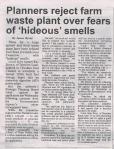Seems there are further problems at Crouchland Biogas, W. Sussex. Actress Julie Walters has now condemned an anaerobic digester close to her organic farm in the little village of Plaistow in West Sussex where residents have been campaigning for many months. Although initially welcoming the creation of a biodigester using agricultural waste she has recently launched a blistering attack.
read the Mail on Sunday article:
What they had thought would be a small farm operation turned out to be an industrial-scale business, bringing in frequent daily deliveries of waste and chemicals. This week, local anger over the plant intensified when effluent from a storage lagoon on the site seeped into local streams, killing fish and forcing farmers to move their livestock.
Now Ms Walters, 66, has launched a blistering attack on the company’s behaviour.
She told planning officers: ‘The biodigester has been erected dishonestly and with cynical disregard for the local people, the environment or the outstanding beauty of the area. Trees are dying around it, wildlife is drowning in its lagoons and people can’t sit in their gardens for the stench.
‘The lanes approaching it are simply not equipped to deal with this degree of heavy traffic.’
The operator, Crouchland Biogas – one of whose directors is Angus Cameron, a cousin of the Prime Minister – receives a taxpayer-funded subsidy campaigners estimate could be as much as £5 million a year.
Crouchland is now locked in a planning battle with West Sussex County Council, which has refused to give retrospective planning permission after the plant exceeded its permitted size. Enforcement notices have been issued and the matter will be decided by a Government planning inspector at a two-day hearing in May.
Mr Roffey said: ‘The initial planning permission in 2007, which everybody supported, was based on it being a small dairy farm with a slurry problem. But through the back door they have turned it into a huge industrial gas plant. It’s disgusting that it has been allowed to continue operating.’
Crouchland managing director Leon Mekitarian said: ‘We create enough clean energy to power nearly 4,000 homes and created over 20 jobs. Last week we sadly experienced an effluent spill from one of our agricultural lagoons. We are working closely with the Environment Agency to reduce the chance of this happening again.’


